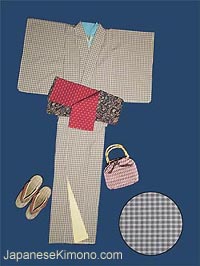|
Home
Kimono
Kimono History
Japanese Clothing
Kimono Fabric,
Kimono Pattern &
How to Make a Kimono
Kimono
Patterns & Kimono Styles
How to Wear a Kimono
Japanese Obi
& How to Tie an Obi Sash
Japanese
Yukata -
The Summer Cotton Kimono
Kimono
Robe & Japanese Robes
How to wear a Kimono Robe and Japanese Robes
Men's Kimono
Hakama Pants
Japanese
Shoes & Japanese Sandal Types
Geta Sandals
Zori
Sandals & Tatami Sandals
Tabi Socks
Children's Kimono
Wedding Kimono
Happi
Coats & Japanese Festival Clothing
Favorite Links
& Sources
Sign our
Guest Book
|
Yukata
- Summer Cotton Kimono
Yukata is the japanese summer cotton kimono. Learn how to wear a yukata,
yukata robe and types of yukata fabric pattern.
The yukata is a japanese summer kimono worn by both men and women. The
name yukata comes from the word
"yu" (bath) and "katabira" (under clothing ).
Thousands of years ago, Court Nobles wore linen "yukatabira" which were
draped loosely after taking a
bath. It gradually became worn by japanese warriors and then by the
general public when the sophisticated japanese public bath became
popular. Today, the traditional japanese yukata is widely used for
everything from festivals, ryokan, summer daily wear to simple night attire. In
Japan, the yukata is the most popular daily clothing wear and is beloved
for its 100% lightweight cotton fabric. The fabric designs vary from the
traditional plain cross hatch pattern to more colorful scenery designs.
of years ago, Court Nobles wore linen "yukatabira" which were
draped loosely after taking a
bath. It gradually became worn by japanese warriors and then by the
general public when the sophisticated japanese public bath became
popular. Today, the traditional japanese yukata is widely used for
everything from festivals, ryokan, summer daily wear to simple night attire. In
Japan, the yukata is the most popular daily clothing wear and is beloved
for its 100% lightweight cotton fabric. The fabric designs vary from the
traditional plain cross hatch pattern to more colorful scenery designs.
 Like American clothing, there are many matching accessories that can be
purchased separately when buying a yukata. The yukata comes from the
manufacturer with a matching cotton 2" sash made of the same fabric
as the yukata. Like American clothing, there are many matching accessories that can be
purchased separately when buying a yukata. The yukata comes from the
manufacturer with a matching cotton 2" sash made of the same fabric
as the yukata.
For normal daily or night attire, just the cotton sash is used.
For festivals and public occasions a larger wider yukata belt as shown in the picture is worn for a more formal appearance. The belt is
simply wrapped around the waist and tucked in at the edge. An obi belt
can also be worn with the cotton yukata. A matching purse, tabi socks
and japanese sandals complete the attire.
shown in the picture is worn for a more formal appearance. The belt is
simply wrapped around the waist and tucked in at the edge. An obi belt
can also be worn with the cotton yukata. A matching purse, tabi socks
and japanese sandals complete the attire.
 NEXT NEXT
|
 of years ago, Court Nobles wore linen "yukatabira" which were
draped loosely after taking a
bath. It gradually became worn by japanese warriors and then by the
general public when the sophisticated japanese public bath became
popular. Today, the traditional japanese yukata is widely used for
everything from festivals, ryokan, summer daily wear to simple night attire. In
Japan, the yukata is the most popular daily clothing wear and is beloved
for its 100% lightweight cotton fabric. The fabric designs vary from the
traditional plain cross hatch pattern to more colorful scenery designs.
of years ago, Court Nobles wore linen "yukatabira" which were
draped loosely after taking a
bath. It gradually became worn by japanese warriors and then by the
general public when the sophisticated japanese public bath became
popular. Today, the traditional japanese yukata is widely used for
everything from festivals, ryokan, summer daily wear to simple night attire. In
Japan, the yukata is the most popular daily clothing wear and is beloved
for its 100% lightweight cotton fabric. The fabric designs vary from the
traditional plain cross hatch pattern to more colorful scenery designs. Like American clothing, there are many matching accessories that can be
purchased separately when buying a yukata. The yukata comes from the
manufacturer with a matching cotton 2" sash made of the same fabric
as the yukata.
Like American clothing, there are many matching accessories that can be
purchased separately when buying a yukata. The yukata comes from the
manufacturer with a matching cotton 2" sash made of the same fabric
as the yukata. shown in the picture is worn for a more formal appearance. The belt is
simply wrapped around the waist and tucked in at the edge. An obi belt
can also be worn with the cotton yukata. A matching purse, tabi socks
and japanese sandals complete the attire.
shown in the picture is worn for a more formal appearance. The belt is
simply wrapped around the waist and tucked in at the edge. An obi belt
can also be worn with the cotton yukata. A matching purse, tabi socks
and japanese sandals complete the attire. 